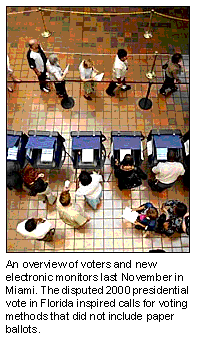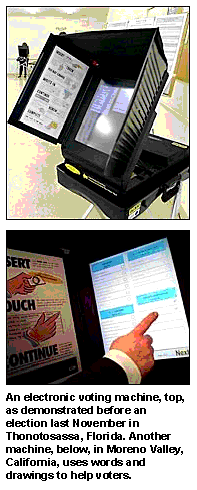 To Register Doubts, Press Here by Sam Lubell
To Register Doubts, Press Here by Sam Lubell To Register Doubts, Press Here by Sam Lubell
To Register Doubts, Press Here by Sam Lubell© 2003 New York Times
Reproduced under the Fair Use exception of 17 USC § 107 for noncommercial, nonprofit, and educational use.
| EJF Home | Where To Find Help | Join the EJF | Comments? | Get EJF newsletter |
| Vote Fraud and Election Issues Book | Table of Contents | Site Map | Index |
| Chapter 7 — Building Better Ballot Boxes |
| Next — A Better Ballot Box? by Rebecca Mercuri |
| Back — Bad Ideas For Voting Just Keep Coming by Charles Corry |
May 15, 2003 — After
the 2000 presidential election, with its disputes over the balloting in Florida and its hanging chad, the federal government moved swiftly to revamp the country's largely paper-based and mechanical voting systems. More than $1 billion has been appropriated for buying electronic voting systems, including optical scanners and touch-screen machines, that eliminate ballots written or punched on paper or tallied by mechanical equipment
 .
.
The new systems have already brought what proponents of electronic voting say is a new reliability and efficiency to the process.
"There's no guesswork as far as who you voted for," said Mark Radke, director of voting industry for Diebold Election Systems, which makes the AccuVote-TS, a $3,000 touch-screen machine. Mr. Radke said the unit, which presents voters with choices on an electronic monitor, quickened the voting and counting process and reduced the number of "undervotes," ballots that are not counted because they are unreadable or otherwise defective.
But not everyone likes the switch to electronic balloting. Some of the loudest opposition, in fact, is coming from computer experts who say the new technology could prove more troublesome than its predecessors. They warn of equipment malfunction, unchecked tampering and the lack of secure proof for each vote.
A group of more than 100 technologists, led by David Dill, a professor of computer science at Stanford University, has called for tighter security measures on electronic voting apparatus and a "voter-verifiable audit trail," meaning a permanent record of each vote that can be checked for accuracy even after the election. (The group's "resolution on electronic voting" is at www.verifiedvoting.org/resolution.asp ).
Without such a trail, Dr. Dill warned, if a machine is tampered with or malfunctions, "then the votes in question are corrupted and you have no option but to hold another election or accept bad results." Thus the only reliable backup, the group contends, is for the machines to print out paper ballots after each vote, which can be hand-counted if necessary.
Dr. Dill and his counterparts, who include computer science experts in academia and Silicon Valley, also assert that unlike more mechanical machines, electronic systems cannot be opened up to the public for verification. And the only people who know what is encoded on them are computer experts.
"I think it's unreasonable for the public to be asked to accept the security of these machines on blind faith,"
he said.
"There's no question the technology is open to tampering."

Members of the group also assert that electronic voting machines have experienced breakdowns in some elections. "We're concerned," said Rebecca Mercuri, formerly a professor of computer science at Bryn Mawr and now the president of Notable Software, a consulting firm. "These machines are showing huge defects."
For their part, election officials and voting machine vendors dispute any notion that the systems have major problems, and caution that the public should not overreact.
Penelope Bonsall, director of the Federal Election Commission's Office of Election Administration, which helps set guidelines for the voting process, said that the possibility of vote tampering has always existed and that the possibilities were no greater with computers.
"When you're dealing with computer scientists, they deal in a world of theoretics, and under that scenario anything is possible," Ms. Bonsall said. "If you probe a little further, the chance of these failures, the risk of that happening wide-scale in a national election is almost nil."
Paul Terwilliger, director of product development at Sequoia Voting Systems, one of the largest manufacturers of electronic systems, said that while no one disputes the need for safeguards, complaints about machines like his company's were uninformed. "I think the concerns being raised are 100 percent valid," Mr. Terwilliger said. "However, they're being raised by people who have little idea about what actually goes on."
Mr. Radke of Diebold added that voters have more, not less, confidence in electronic machines. He pointed to a study conducted in February at the University of Georgia that found that 70 percent of voters in the state's November 2002 elections, which were conducted on Diebold machines, reported being very confident that their vote was accurately counted. When this question was asked in September 2001, before electronic voting was in place in the state, only 56 percent of Georgia voters reported being very confident.
In Johnson County, Kansas, Connie Schmidt, the county election commissioner, said a feedback card in the August 2002 statewide primaries found that 99 percent of voters were pleased with their Diebold machines. "They've been extremely reliable, and we've received tremendous feedback from voters," Ms. Schmidt said.
Electronic voting is not new. Optical scans have been used in some voting districts since the 1960's, and federal election officials first began feasibility studies on the use of computers in voting in the early 1980's. Touch-screen systems have been in limited use since about 1988, Ms. Bonsall said.
This is also not the first time that questions have been raised about whether electronic voting can solve the ills of paper or mechanical balloting or whether it might introduce new problems. But the concerns have increased as the move to electronic voting gained speed following the 2000 Florida vote, when some punch-card ballot systems confused voters and there were frequent disputes over whether ballots were fully punched.
According to the Federal Election Commission, by 2002 19.6 percent of votes nationwide were recorded on touch-screen equipment, up from 3.9 percent in 1992. Another 31.6 percent of votes in 2002 were recorded using optical scanning equipment. And with the recent federal appropriations, those percentages will keep growing.
Touch-screen machines use resistive screen technology that responds to finger pressure on the screen. Voters are given electronic cards when they sign in at the polling place and then swipe them through a reader before casting their votes. Votes are counted by software, and tallies are available almost instantly at the end of the voting day. The results are generally backed up on CD-ROM's.
Optical scan machines work similarly to machines that grade standardized tests, separating marks on the ballot made with pencils. All machines record and tally votes internally and can print a final vote total.
Mike Kernell, a longtime Tennessee state assemblyman from Memphis and a technology enthusiast, is concerned about future elections because the new machines are harder to get a look at. "We used to be able to check the machines and see if they'd been tampered with," he said. "It is now almost impossible." Mr. Kernell wonders whether he will have to hire a computer programmer in his next race to make sure the machines are working smoothly and haven't been tampered with. "We've hit a brick wall," he said.
Along with Dr. Dill, endorsers of the resolution include professors from Yale, M.I.T., Princeton, the University of California at Berkeley, Bryn Mawr and Johns Hopkins, as well as industry experts from Apple, Sun Microsystems, Cisco and Unisys. Dr. Mercuri has written substantially on electronic voting and is one of the group's most outspoken members. She worries that no electronic voting system has been certified to even the lowest level of federal government or international computer security standards, nor has any been required to comply with such.
Dr. Mercuri said the machines had had problems in some elections. In March 2002, for example, in Wellington, Florida (in Palm Beach County, the epicenter of the 2000 dispute), there were 78 unrecorded ballots in a City Council election conducted with electronic machines. That represents about 3 percent of the total votes.
"Computers are good for many things, but at the same time we need to be cautious. If a machine's not functioning, then it might not be able to shut itself down," Dr. Mercuri said.
But Theresa LePore, the Palm Beach County elections supervisor, said that the Wellington election went smoothly and that the nonvotes were deliberate. "We had no problems with the equipment whatsoever," she said. "A number of people had come in to vote and had never cast their ballot. We had comments from voters that people didn't want to vote for either candidate."
Mr. Radke of Diebold said that machines were designed so that if problems occurred, votes would not be lost. "When you have that many terminals deployed, you have something that will happen or a minor malfunction," he said. "But nothing that would affect any of the votes."
Mr. Terwilliger added that all election software was monitored by independent testers, authorized by the government, to make sure source code is up to par. Ms. Bonsall confirmed that such testers were the norm and were currently accredited by the National Association of State Election Directors.
Dr. Dill argued, however, that if voting machines were really secure, then voters would be able to see the insides of their "proprietary" technology. "If someone really has a tamper-resistant machine, they should tell you enough about how the machine works so you can assure yourself that the machine works," he said. "We don't know what the weaknesses are. We don't know who the people are that control that stuff."
Mr. Terwilliger said that Sequoia was willing to share its source code, provided viewers sign nondisclosure agreements. But he questioned the need for a paper-based audit trail. "What's so great about a piece of paper?" he said. "I can tamper with a piece of paper with a pencil or pen. All I need is physical access and I can tamper with the election."
Ms. Bonsall, too, is skeptical of the need for a paper trail.
"If you have electronic machinery, why would you ever do a paper count?" she said. "If you have to deal with pieces of paper I think that you're defeating your purpose."
Many election officials appear happy with the machinery, although they concede its inherent problems. "With so many humans who have an opportunity to interface with a machine occasionally things happen," said Denise Lamb, director of Bureau of Elections in New Mexico, where computerized machines have been in use since the late 1980's.
Ms. Lamb acknowledges occasional errors, like misprogrammed machines or voters who cannot figure out the apparatus, but over all, she said, "they're very reliable, and voters like them."
"I think that any voting system, if it is programmed and used properly, can be very reliable," she added.
| EJF Home | Where To Find Help | Join the EJF | Comments? | Get EJF newsletter |
| Vote Fraud and Election Issues Book | Table of Contents | Site Map | Index |
| Chapter 7 — Building Better Ballot Boxes |
| Next — A Better Ballot Box? by Rebecca Mercuri |
| Back — Bad Ideas For Voting Just Keep Coming by Charles Corry |